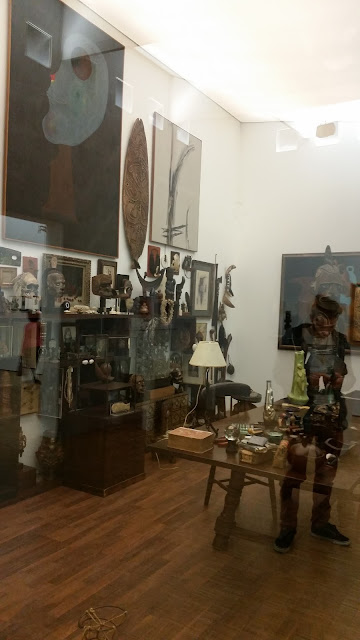One of the signal facts of artistic movements in Paris in the first half of the twentieth century is the influence of African art on the painters and writers who created what we now refer to as Modernism. I put the word African in inverted commas in the title to this post to indicate that what Picasso, Matisse, Breton, and others were borrowing from was as much their own, sometimes erroneous, ideas about Africa, as much as the physical objects that fascinated them so. That said, you can't visit museums in Paris without finding evidence for the importance of this south-to-north current of influence.
The Musee du Quai Branly houses objects from Africa, the Americas, and Oceania, and early in January I made my first ever visit to the collection:
This is the source material, or very similar to it, for the statues that Picasso saw in the Louvre in the early 1900s, and which inspired his 'primitive' painting of the female figure in Les Demoiselles d'Avignon, the foundational painting of Cubism. At the Louis Vuitton Foundation, I saw an exhibition of masterpieces from the Schukhin collection (grand patron of Matisse and Picasso, a Russian who lined his palace with paintings which were confiscated by the Bolsheviks and which form part of the Hermitage collection). Among the works by Picasso were studies for the Demoiselles, in gouache:
The similarity between Picasso's work and the African wood carvings is especially noticeable in the simplified forms of heads and torsos.
Then at the Centre Georges Pompidou, the studio room of Andre Breton is displayed in its entirety behind a room-length wall of glass:
This takes us up to the middle part of the twentieth century. Breton was a member of the Surrealist movement, and the paintings and objects in this room are in a variety of styles. But once again, there are African masks and figures everywhere. I suspect that to a Surrealist, the attraction would have been that the anonymous men and women who created these objects were accessing their unconscious, unfiltered by the intellectual theorising of Western art. No doubt this is a crude and patronising way of thinking about African art, but the point is that this is close to what twentieth century Modernists thought, and that these beliefs, whether mistaken or not, were a driving force in the renewal and regeneration of art and literature after 1907.
The Musee du Quai Branly houses objects from Africa, the Americas, and Oceania, and early in January I made my first ever visit to the collection:
This is the source material, or very similar to it, for the statues that Picasso saw in the Louvre in the early 1900s, and which inspired his 'primitive' painting of the female figure in Les Demoiselles d'Avignon, the foundational painting of Cubism. At the Louis Vuitton Foundation, I saw an exhibition of masterpieces from the Schukhin collection (grand patron of Matisse and Picasso, a Russian who lined his palace with paintings which were confiscated by the Bolsheviks and which form part of the Hermitage collection). Among the works by Picasso were studies for the Demoiselles, in gouache:
The similarity between Picasso's work and the African wood carvings is especially noticeable in the simplified forms of heads and torsos.
Then at the Centre Georges Pompidou, the studio room of Andre Breton is displayed in its entirety behind a room-length wall of glass:
This takes us up to the middle part of the twentieth century. Breton was a member of the Surrealist movement, and the paintings and objects in this room are in a variety of styles. But once again, there are African masks and figures everywhere. I suspect that to a Surrealist, the attraction would have been that the anonymous men and women who created these objects were accessing their unconscious, unfiltered by the intellectual theorising of Western art. No doubt this is a crude and patronising way of thinking about African art, but the point is that this is close to what twentieth century Modernists thought, and that these beliefs, whether mistaken or not, were a driving force in the renewal and regeneration of art and literature after 1907.




